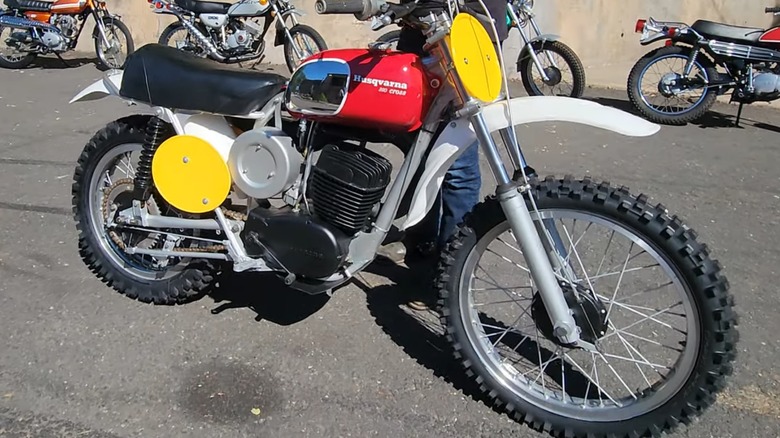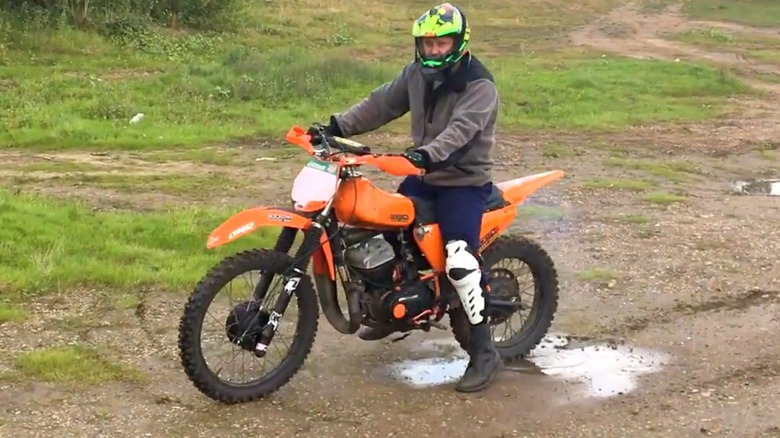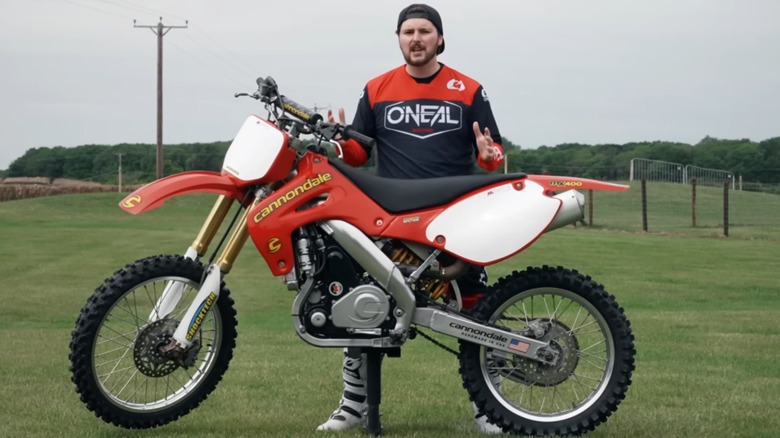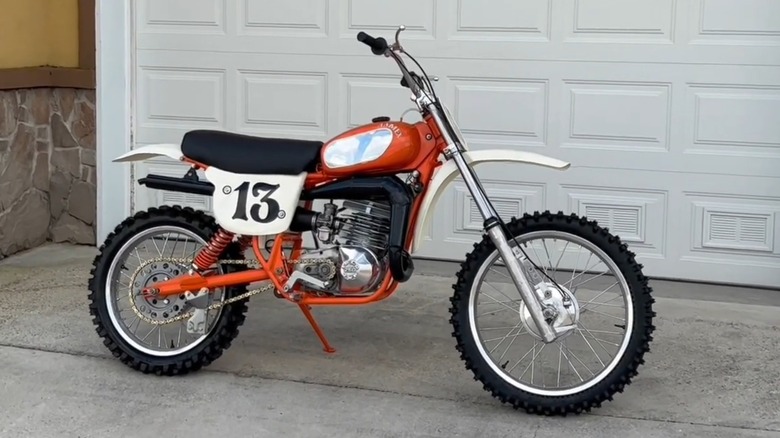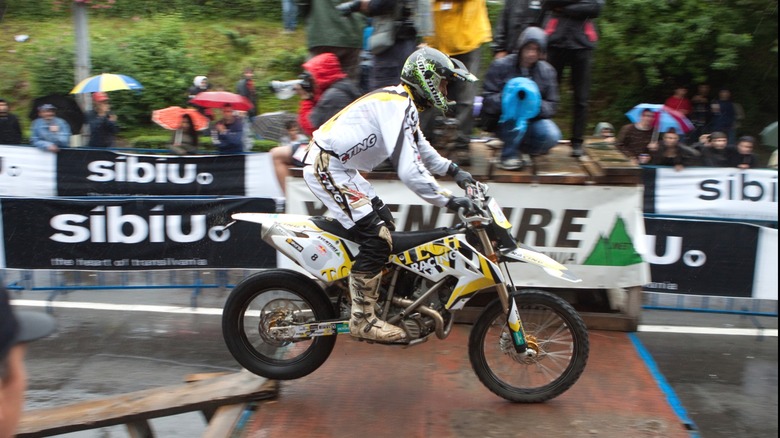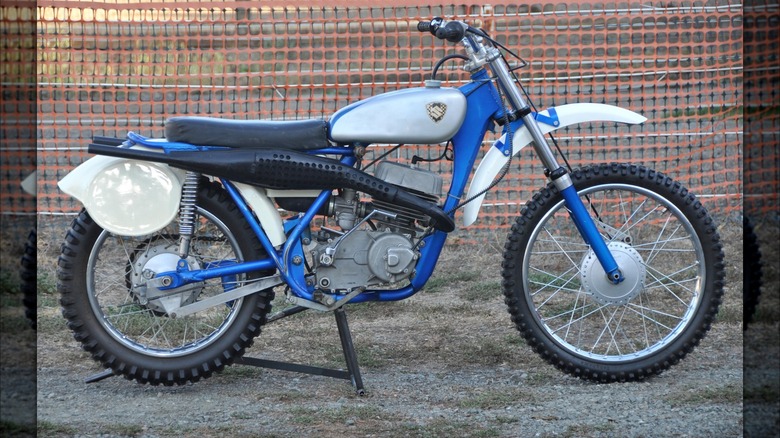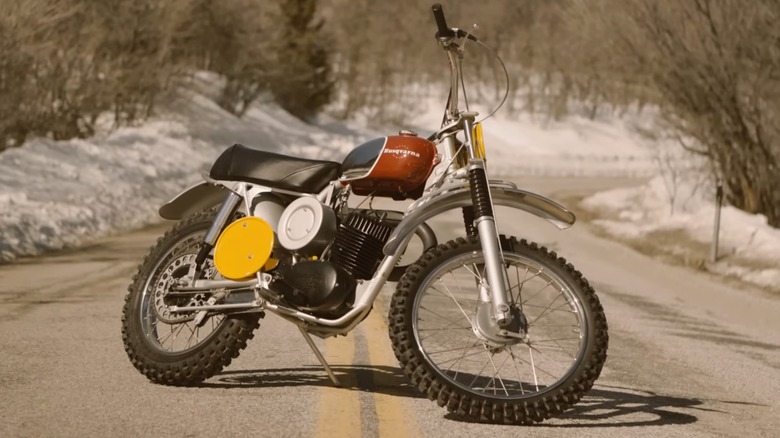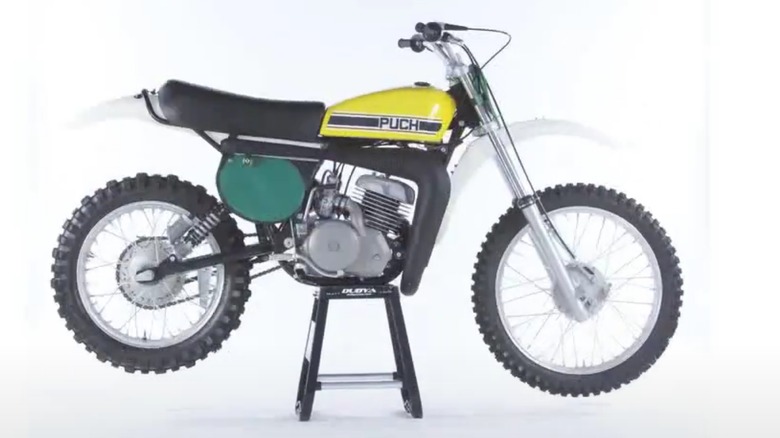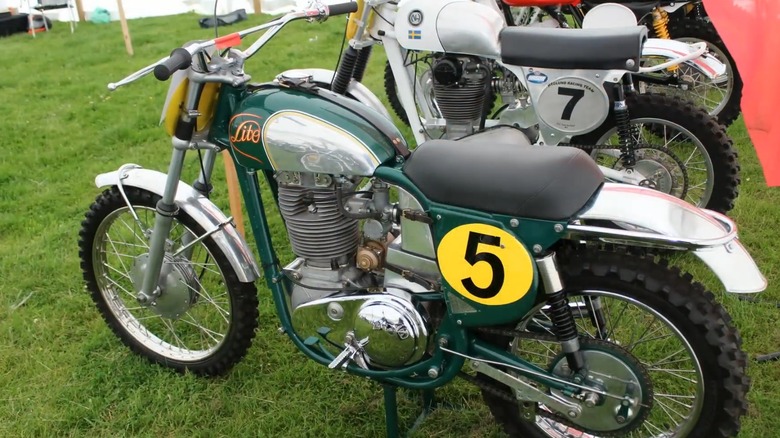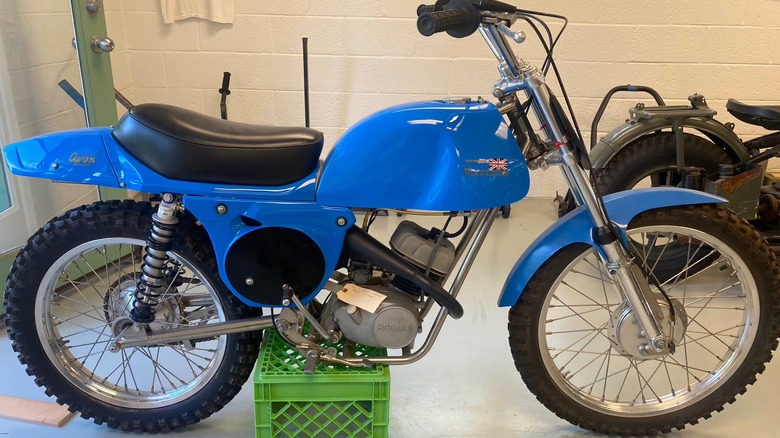These Dirt Bikes Are Some Of The Rarest In Existence
Riding dirt bikes is an experience like no other. The freedom of hitting the trail with horsepower on demand is a compelling idea, and manufacturers have been building and distributing machines for many decades to fulfill a demand for ever-more-rugged bikes. Motorcycles modified to use for scrambles, which were races occurring off-road on a set course, became popular following WWI, and surplus military motorcycles after WWII continued to fuel the popularity. Only in the 1950s did manufacturers produce dedicated off-road motorcycles that would eventually be called dirt bikes.
Since then, there have been dozens, if not hundreds, of brands of motorcycle coming from all corners of the globe. Japan is well-known for Yamaha, Suzuki, Honda, and Kawasaki, but in the 1950s, there were innumerable brands trying to make it and these now classic dirt bikes paved the way for today's sophisticated sport. While most of these were street bikes, dirt bike production through the '60s gave rise to global brands such as Husqvarna, CZ, KTM, Maico, Can-AM, and more. With so many manufacturers duking it out for sales, many models did not sell well and are rare today but not necessarily valuable. Considering the vast graveyard of dirt bike manufacturing, shooing rare bikes is a bit of a subjective exercise. Nonetheless, here are the rarest models of dirt bike all with attributes that make them worth celebrating.
Izh K-16
If you have never heard of Izh motorcycles, you likely grew up in the West. The name of the company is more properly written Иж, which uses Cyrillic letters as the company is Russian. In the 1920s, Izhevsk Machine-Building Plant began manufacture of motorcycles in addition to its better-known products, rifles, including the Kalishnakov AK-47 from 1949.
Izh produced many models throughout the existence of the Soviet Union, including a 2-stroke dirt bike in the later years called a K-16. This bike looked much like its contemporary European and Japanese counterparts. Power came from a 350cc single cylinder 2-stroke engine fed by a Jikov carburetor and ignition provided by Motoplat, and its design borrowed from fellow communists at CZ. While its specifications look promising, the bike was not even favored by Soviet citizens, who preferred Czech dirt bikes and highly-prized machines from Japan, and production ended in 1986.
Reliable numbers of total production are hard to find, however, plans to export it to the West never materialized. Considering the extreme difficulties in buying any high-ticket item in the Soviet Union, particularly in its waning years, it should be safe to assume production was low compared to foreign makes. Considering Bring a Trailer shows only one Izh — and not a K-16 at that — model ever listed on its site, finding one for sale outside of the former Soviet Union is probably next to impossible.
Cannondale X400
In the late '90s, Cannondale was at the top of its game having established itself as a premier manufacturer of bicycles and leading with innovations and designs that set standards for the industry. Nowm Cannondale is now among the top makers of electric bicycles. Not wanting to become complacent, the company looked for opportunities to expand its horizons and saw opportunity after the introduction of Yamaha's first 400cc 4-stroke bike, a groundbreaking model for dirt bikes in 1997.
The Cannondale X400 debuted in 2001 with a lightweight aluminum frame, fuel injection, and electric start years before the competition. Its engine also flowed in reverse from contemporary bikes, meaning the fuel injection sits in the front and exhaust flows out the back, another feature adopted years later by others. Despite these novel attributes, performance lacked and sales suffered, bankrupting the company in 2003.
Following bankruptcy, the motor division of Cannondale was taken over by ATK, an American high-performance boutique maker of dirt bikes. The original Cannondale built machines were only on the market for a couple of years and were not only subject to negative press, but they were also extremely expensive. Production numbers are not easy to find, but similarly difficult to find is a listing of one for sale. Classic.com shows only a single sale in 2021 in the auction market. Private listings are seemingly non-existent at the time of writing, so those looking for one will need to be on their game when it becomes available.
Ammex 250 MX
Motocross racing in the 1970s was a Wild West period when manufacturers, race teams, and riders threw everything they had at a frame to squeeze as much power as possible out of them. Furthermore, the proliferation of companies building bikes gave riders a wide choice of models to ride. However, sometimes a good rider knows exactly what they want and decides to make it happen himself, as is the case with the Ammex 250.
Four-time championship rider Gary Jones used earnings from racing to build a better bike. Taking over parts of another failing motorcycle manufacturer and moving production to Mexico in contract with Moto Islo to produce a new line of bikes, Jones created and built the new Ammex 250 for motocross racing. Unfortunately, reliability issues plagued early models. The problems were ironed out, but by the time that happened, the value of the peso had fallen off a cliff and Moto Islo was forced to end production.
About 1,500 Ammex 250 units were made over just a few years of production. It is still the only dirt bike designed and built by a motocross champion, making them special and rare machines today. One sold in 2023 for $15,000, a princely sum for a 1970s dirt bike.
BMW G450X
After BMW Motorrad made among most successful motorcycles for more than a century, it sought to enter the dirt bike game only after the new millennium. Sadly, it didn't last long. The company currently offers a range of adventure bikes and dual-purpose machines, but its foray into competition level dirt bikes lasted only a few years. Is G450X model arrived with several innovative features, but it was likely its high levels of sophistication and high price, about $9,000 in 2009, that caused its downfall.
The DOHC single-cylinder engine of this bike is a fuel-injected unit producing up to 51 horsepower. It's as highly refined as you'd expect from BMW, and it includes many novel features. Overall, this is a bike with competitive power ratings, excellent build quality, and the support of a legacy manufacturer, so it should have done well.
In competition, riders found difficulty ironing out problems to make the bike perform better. BMW engineers were not receptive to suggested improvements to the bike. Furthermore, clutches went out during multiple races, suggesting the novel design was not working. Rather than continuing to improve the bike, it was killed off, ending BMW dirt bike production. While these bikes today are not rare in the way a pre-war Indian is, they are very hard to find. Sold as road-legal bikes in Europe, current registrations in the U.K. show only five registered. Furthermore, a nationwide U.S. search of Cycle Trader shows only two available at the time of writing.
1968 Suzuki TM250
Although Suzuki was founded in 1909 in Shizuoka, motorcycle production did not begin until the 1950s, and production quickly ramped up to make it one of the leading manufacturers of motorcycles worldwide. With its success selling small and affordable models for basic transportation came the ability to branch out into other markets, eventually including dirt bikes, where it positioned itself as one of the leading marques.
Attempting to overcome the notion at the time that products from Japan were cheap, shoddy, and underpowered, Suzuki worked for four years to develop its first successful dirt bike, the TM250. By the time it made it to the pages of Cycle World in March of 1968, Suzuki had proven it could build a competitive bike at the top of its class for power and handling.
Regular production versions of the Suzuki TM250 were made for the 1971 through 1975 model years. These bikes featured the yellow and black color palette used on Suzuki bikes throughout the '70s and '80s, essentially proving Suzuki could build and sell excellent dirt bikes. The silver and blue TM250 from 1968 was a pre-production model made for testing and development. 112 bikes were built, of which about 60 were sent to the U.S. for testing. They came with a questionnaire requesting input from riders to help tweak the bike for production. They are extraordinarily rare, and Bonham's estimated a value of about $30,000 to $40,000 in 2015 that is likely to rise going forward.
1966 Husqvarna 250 Cross
From the early 20th Century, Husqvarna, itself a company with three centuries of operation, has built motorcycles of exceptional quality. Husqvarna rifle production began in Sweden in 1689, and diversification and innovation with the times has kept it around today.
While Husqvarna built street bikes for most of its early motorcyle days, it was in the '50s that its 175cc Silverpilen, or Silver Arrow in English, a name revived with the recently introduced Husqvarna Svartpilen, or Black Arrow, started to make waves on the dirt and help establish it as a maker of championship dirt bikes. The success of that model prompted the company to continue developing off-road bikes while increasing power, handling, and reliability. It was in 1968 that its new 250 Cross made a breakthrough in the American market, particularly when Steve McQueen rode one on the track and in his movie, "On Any Sunday."
1966 was the first year for these Swedish machines in America. Initially, nine bikes were exported and used for motocross racing, a new sport at the time. While sales took off quickly, especially once people saw the Husky dominate on the track, the early models continue to be valuable. 300 were made in 1966, of which just 76 were imported into the U.S.
Puch MC250
Although it is not well-known in the United States, Puch has made wheeled products in its home country of Austria since the 19th Century. It was only after the turn of the century that a motorized product was built, and its motorized bicycles, commonly called moped, became among its most successful products worldwide. In the U.S., Puch sold a range of mopeds with small 2-stroke engines and pedals from 1974 to 1986, but offered a much wider range of motorcycles, mopeds, and scooters elsewhere. Among them was a high-performing 250cc model with a unique fuel delivery component.
Puch's MC250 is a dirt bike that was designed and built to race motocross, and it not only raced, it won. The 1975 FIM 250 World Championship was won on the Puch 250, likely gaining the title thanks to its unique dual-carb setup. For 2-stroke engines, fuel enters the crankcase and gets delivered to the combustion chamber through ports in the engine. They can use one-way reed valves in the cylinder or rotary valves in the crankcase to deliver the fuel and air mix. For the TM250, Puch provided its magnesium engine with both ports and valves, each with a dedicated carburetor feeding it.
The Puch was very expensive in its day, and only one was made for competition, with 97 factory production replicas made after that. In 2021, Mecum offered one copy of the MC250 at its Las Vegas auction but did not sell, despite receiving bids up to $37,000.
1961 Lito 500 Motocross
The Swedes have played an outsized role in motocross from the start. And while the Husqvarna 250 Cross made a splash when it arrived in 1966, fellow Swedish manufacturer Lito helped pave the way for that success. From 1961 through 1965, Lito produced what are arguably some of the best motocross bikes of the era, albeit in small batches of handmade machines.
Lito was what could be called a boutique motorcycle manufacturer, building individual machines by hand with the goal of making a premium machine over gaining mass market appeal. They typically, but not exclusively, used British components such as BSA frames and engines, tweaking them and assembling them into a bike capable of racing on the track and winning. Lito only built 35 bikes in total, but they were good enough to win races, coming in first, second, and third from 1961 to 1963.
The honor of owning one of these exclusive vintage dirt bikes comes with a hefty price tag. One recent sale by Mecum in 2019 yielded a winning bid of $82,000. Unless something drastic happens to the vintage motorcycle market, expect that to only rise in the future.
1970 Webco Rickman 125
In the late '60s, motocross became an extraordinarily popular sport, gaining riders from multiple continents eager to race in classes from amateur to pro. While some received factory support for fancy race teams, most modified their machines with parts off the shelf. Webco was an aftermarket supplier at this time and offered upgrades for a wide range of bikes, but went further in creating a complete package using power from the Hodaka Super Rat power, its most popular model.
Hodaka was a small but plucky dirt bike manufacturer from Oregon with production facilities in Japan. Its bikes rugged, finding favor by many riders at the time. As a small player in the market, sales peaked in 1972 at only 15,736. Webco installed its custom Hodaka kit to bump up displacement to 125cc and mounted it on a Rickman Hodaka, a product of a boutique British bike builder.
The Webco bike and the Rickman base are both unique and attractive, and they help to tell the tale of the oft-forgotten Hodaka, which ceased production in 1978. The Webco bike is not a pure production model, but it used a regular production kit rather than a conglomeration of parts, which makes it close enough. 412 examples were built by Rickman, but only one was converted by Webco, though have likely existed. These are desirable and rare today, with at least one recent Mecum Rickman Hodaka auction reaching a final bid of nearly $20,000.
